#Discover the Hidden History of Tomb Robbing in Ancient Egypt
Explore tagged Tumblr posts
Text

Discover the Hidden History of Tomb Robbing in Ancient Egypt
Criminals plundered the riches of Egyptian pyramids and underground burials, often within a few years or, in some cases, within a few hours of occupants’ interment.
On November 4, 1922, workers led by British archaeologist Howard Carter noticed a single stair peeking out from beneath the shifting Egyptian sand. Within three weeks, Carter and his team had excavated enough limestone debris and soil to reveal a stairwell that led to the antechamber of an ancient tomb.
After five long years of searching, Carter had found the tomb of Tutankhamun, deep beneath the Valley of the Kings, a site west of the Nile River. Boring a tiny hole in the second door to the antechamber, the archaeologist peered through, using the light of a single candle to survey a small room crammed with a motley mix of furniture, gilded animal heads and dismantled chariots, as well as other priceless treasures last seen more than 3,000 years prior.
The 18th Dynasty ruler’s tomb was the single most consequential discovery of Egyptian antiquities to date; its importance lay not just in the treasures hidden inside, but in the fact that the burial had somehow survived the robbers who had emptied out nearly every other ancient Egyptian tomb. Only a few royal graves rival Tutankhamun’s in splendor. Chief among them is the intact tomb of Psusennes I, known as the Silver Pharaoh because of the silver coffin that housed his mummy.

The silver coffin of Psusennes I.
In an ancient society with a stark separation between the rich and the poor, tomb robbing was ubiquitous. Nobles literally buried their wealth while living alongside people who often didn’t have enough food to feed their families. Plundering burials was a shadow economy driven by criminals who often had inside knowledge of the tombs. It’s likely that many looters either helped build the structures themselves or paid off someone involved in the tombs’ construction, says Betsy M. Bryan, an emeritus Egyptologist at Johns Hopkins University.
Some grave robbers were stonecutters and craftsmen who left gaps in tombs’ walls or knew which bedrock was soft enough to tunnel through to reach the treasures housed within. Others schemed to evade or pay off security left to guard the tombs. These thieves were well connected, calculating and decidedly precise in their criminal endeavors, Bryan says.
“Evidence from the Old, Middle and New Kingdom[s] shows that tomb robbers could be remarkably patient and work over lengthy time periods to create tunnels into tombs that they thought would be rich [with treasures],” she says.

Aboveground structures like the Step Pyramid of Djoser were natural targets for tomb robbers.
Looting happened consistently throughout the history of ancient Egypt, but it was most prevalent during the First and Second Intermediate Periods, which followed the Old and Middle Kingdoms, respectively. Without a strong ruler in place, power became decentralized, and the state had less money to protect its graves. The end of the New Kingdom also ushered in a period of corruption and uncertainty that resulted in widespread tomb robbing.
Officials took a range of steps to prevent tomb robbing, like carving curses on doors to scare would-be looters away. Some tombs, like the pyramid complex of Djoser, were filled with debris to block passage to the burial chambers. During the New Kingdom (circa 1550 to 1070 B.C.E.), sovereigns were buried underground instead of in aboveground pyramids. Workers tasked with building these hidden tombs lived in Deir el-Medina, a village near the Valley of the Kings. Though the isolated, close-knit nature of the community was intended to lower the likelihood of theft, it ultimately had the opposite effect, encouraging looting by the very people assigned to protect the dead.
Workers tasked with sealing tombs had the best access to the treasures hidden within. They were often the last ones out, so no one was the wiser if they ransacked the tombs they’d been hired to protect, says Aidan Dodson, an Egyptologist at the University of Bristol in England. Sometimes, the burials would appear untouched, but once the coffin was opened, the golden mask that once adorned the pharaoh’s face would be missing.

Ruins of Deir el-Medina, a village occupied by the workers who built the tombs in the Valley of the Kings.
In other cases, when a mummy was unwrapped, the jewelry that had been placed inside was gone, stolen by the undertakers who’d prepared the dead for burial, Dodson says. He adds, “Resin was used in embalming, and there would be places on the body where there was an impression of a piece of jewelry that was no longer there.”
When the tomb of Nefermaat, an ancient Egyptian prince, was uncovered in 1871 at Meidum, archaeologists at first thought it was intact, sealed up tight for 4,000 years. But once inside the burial chamber, the scene was chaotic. “Everything was smashed to pieces,” Dodson says. “It had been robbed [and] the mummy broken.”
After a heist, ancient tomb robbers moved on to the next phase of the crime: trafficking their stolen goods in exchange for payment. This, too, required forethought. Getting caught bartering the mask of a pharaoh, for example, would have been cause for execution by impalement on a stake. To avoid this fate, criminals went after treasures that couldn’t be traced, like gold and other precious metals that could be melted down without buyers knowing their origin. In some cases, robbers would steal highly valuable perfumed oils to sell on the international market. Thieves also burned gilded furniture and statues to remove the gold that once adorned them, Dodson says.

Papyrus Mayer B, a legal document detailing the trials of tomb robbers during Egypt's 20th Dynasty.
Historical evidence of tomb robbing comes primarily from a set of papyri detailing trials that took place in Thebes during the New Kingdom, specifically the 20th Dynasty, which spanned 1189 to 1077 B.C.E. The legal documents provide a window into the individuals who carried out the robberies directly, who knowingly fenced looted treasures or who ferried thieves across the Nile to sell their sacred finds, Bryan says.
“We took our copper tools and forced a way into the pyramid of this king through its innermost part,” said a mason named Amenpanufer in a confession dated to around 1110 B.C.E. After stripping the royal mummies of their gold, amulets and jewels, Amenpanufer and his fellow thieves “set fire to their coffins [and] stole their furniture.” The robbers then divided the tomb’s spoils among themselves.
The papyri point to a time when the state was in turmoil, says Salima Ikram, an Egyptologist at the American University in Cairo. Rampant tomb looting coincided with a period of unrest, famine, outside attacks and constant transitions in power.
“In the 20th Dynasty when we have a lot of royal tomb robbery, the state couldn’t provide, and that’s why people were taking matters into their own hands,” says Ikram.
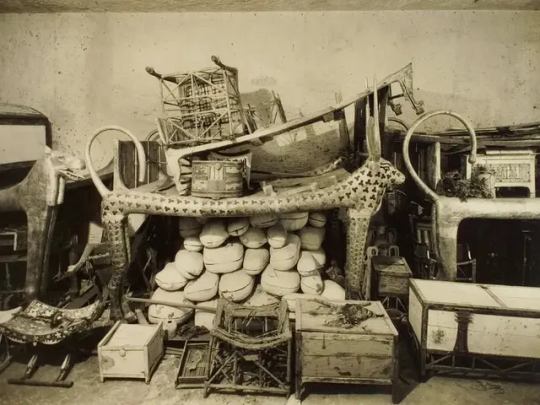
Tutankhamun's tomb was one of the few royal Egyptian burials left largely untouched by ancient looters.
Still, tomb robbing wasn’t confined to times of unrest. Even Tutankhamun, who ruled during the 18th Dynasty (approximately 1550 to 1292 B.C.E.), when Egyptian civilization was at its peak, was the victim of theft. Inside the antechamber of the king’s tomb, Carter’s team found bags of abandoned loot. According to Dodson, the thieves appeared to have been caught in the act and forced to leave their ill-gotten goods behind.
Tomb robbing was one of the worst crimes an ancient Egyptian could commit, as tombs were considered sacred vehicles that provided passage to the afterlife. “Elite society was geared toward eternal life,” says Maria Golia, author of A Short History of Tomb-Raiding: The Epic Hunt for Egypt’s Treasures. Nobles were mummified and packed in a tomb with their belongings, all of them necessities, because “the afterlife was viewed as an extension of their current life,” Golia explains.
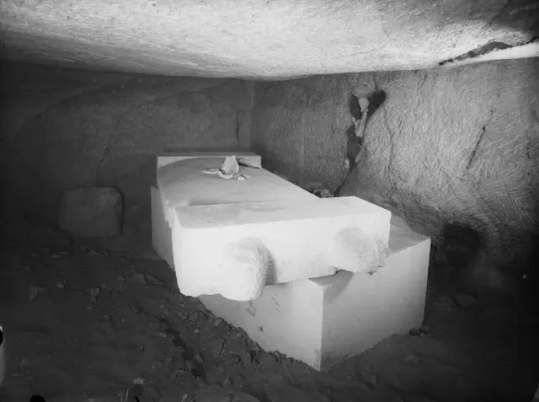
The white limestone sarcophagus of Nefermaat, whose tomb was looted by robbers.
Destruction of a tomb was, in a sense, a form of murder—a fact reflected in the brutality of documented punishments, Ikram says. Some accused criminals had their hands cut off, while others were impaled, a form of execution where a stake was inserted into the anus, perforating the body all the way up to the torso.
No matter the punishment, noble tombs remained ripe for theft throughout ancient Egypt’s 3,000-year history—and beyond. After the civilization fell into decline, thievery gave way to treasure hunting, with residents of the region no longer revering Egyptian religion or fearing the curses of the dead, says Dodson. Stealing from tombs was hardly considered a crime anymore. By the late 19th century, seizing such riches was a government-sanctioned practice, with archaeologists excavating tombs in the name of science.
In an ancient world marked by haves and have-nots, loot tucked inside pyramids and buried underground presented an opportunity for an irresistible crime, especially as the once-great Egyptian empire lost power. What was formerly sacred was now a means for feeding a family, Golia says.

Plunderers' loot found in King Tut's tomb.
“This was a system built on burying money, even entire households, underground,” she says, “and while the architects only had one shot at building an impenetrable tomb, the robbers had all the time in the world to figure out how to get in.”
By Sarah Novak.
#Discover the Hidden History of Tomb Robbing in Ancient Egypt#howard carter#tomb#ancient tomb#tomb robbery#grave#ancient grave#grave robbery#treasure#looting#ancient artifacts#archeology#archeolgst#history#history news#ancient history#ancient culture#ancient civilizations#ancient egypt#egyptian history#egyptian art#egyptian pharaoh#long post#long reads
53 notes
·
View notes
Text
Not really hidden if you've done any reading about ancient Egypt, but an interesting article nevertheless.
20 notes
·
View notes
Text
April 6 2024 Barcelona

We love spending time with our friends Johanna and Joan and their sons Dawit and Ziyang. They are usually up for most adventures so today we visited the Ideal Center for Digital Arts in Poble Nou, where the King Tutankhamun exhibition was taking place. Bruce and I had attended this exhibition few months ago, before we went to Egypt in February and it fascinated us and helped a bit to prepare us for what we would experience on our Egyptian tour. We wanted to share it with our friends because we knew they also had an interest in Egyptian history. They LOVED it, especially the kids!

During the video presentations in the main theater the images were displayed on the four walls surrounding the room, giving viewers the feeling of almost being in the scenes. This 3-D experiences is one of my favorite things about the exhibitions here. There is also a Metaverse which is even more intense but I always enjoy this one because of the slower pace. It was exciting to recognize these obelisks from our trip to the Karnak temple in Luxor.


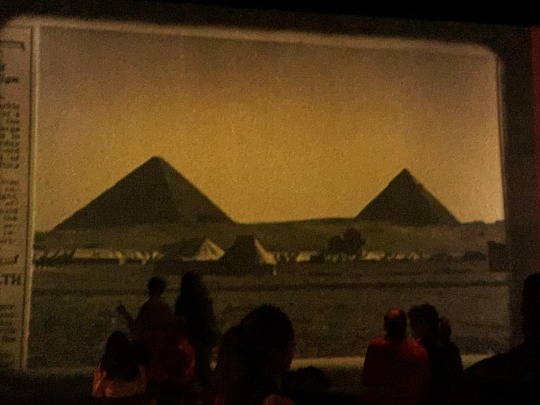
For those who might be unaware of the story of King Tutankhamun´s tomb, here is a short version from Wikipedia:
"The tomb of Tutankhamun was discovered in the Valley of the Kings in 1922 by excavators led by the Egyptologist Howard Carter more than 3,300 years after Tutankhamun's death and burial. Whereas the tombs of most pharaohs were plundered by graverobbers in ancient times, Tutankhamun's tomb was hidden by debris for most of its existence and therefore not extensively robbed. It thus became the only known near-intact royal burial from ancient Egypt.
The tomb was opened beginning on November 4 1922 during an excavation by Carter and his patron, the 5th earl of Carnarvon. The burial consisted of more than five thousand objects, many of which were in a highly fragile state, so conserving the burial goods for removal from the tomb required an unprecedented effort. The opulence of the burial goods inspired a media frenzy and popularised ancient Egyptian-inspired designs with the Western public. To the Egyptians, who had recently become partially independent of British rule, the tomb became a symbol of national pride, strengthening Pharaonism, a nationalist ideology that emphasised modern Egypt's ties to the ancient civilisation, and creating friction between Egyptians and the British-led excavation team. The publicity surrounding the excavation intensified when Carnarvon died of an infection, giving rise to speculation that his death and other misfortunes connected with the tomb were the result of an ancient curse.
After Carnarvon's death, tensions arose between Carter and the Egyptian government over who should control access to the tomb. In early 1924, Carter stopped work in protest, beginning a dispute that lasted until the end of the year. Under the agreement that resolved the dispute, the artefacts from the tomb would not be divided between the government and the dig's sponsors, as was standard practice in previous Egyptological digs, and most of the tomb's contents went to the Egyptian Museum in Cairo. . In later seasons media attention waned, apart from coverage of the removal of Tutankhamun´s mummy from its coffin in 1925. The last of the burial goods were conserved and shipped to Cairo in 1932.
The tomb's discovery did not reveal as much about the history of Tutankhamun's time as Egyptologists had initially hoped, but it established the length of his reign and gave clues about the end of the Amarna Period, which preceded his reign. It was more informative about the material culture of Tutankhamun's time, demonstrating what a complete royal burial was like and providing evidence about the lifestyles of wealthy Egyptians and the behaviour of ancient tomb robbers. The interest generated by the find stimulated efforts to train Egyptians in Egyptology. Since the discovery, the Egyptian government has capitalised on its enduring fame by using exhibitions of the burial goods for purposes of fundraising and diplomacy, and Tutankhamun has become a symbol of ancient Egypt itself.
The tomb was robbed twice soon after its construction. Officials restored and resealed it, filling the entrance passage with chips of limestone to deter further intrusion. During the reigns of Ramesses V and Ramesses VI, nearly two centuries after Tutankhamun's death, his tomb was covered by debris from the construction of their tomb, Tutankhamun's tomb was thus hidden from later waves of robbery so that, unlike the other tombs in the valley, it retained most of the goods it was stocked with.

The pharaoh Tutankhamum ruled during the Eighteenth Dynasty, during the New Kingdom. He died c. 1323 BC and was entombed in the Valley of the Kings near Thebes (modern Luxor), like most New Kingdom rulers. Instead of a full-size royal tomb cut into the slopes of the valley, he was interred in a small tomb dug into the valley floor, probably a private tomb that was modified to fit the large amount of goods that accompanied a royal burial."
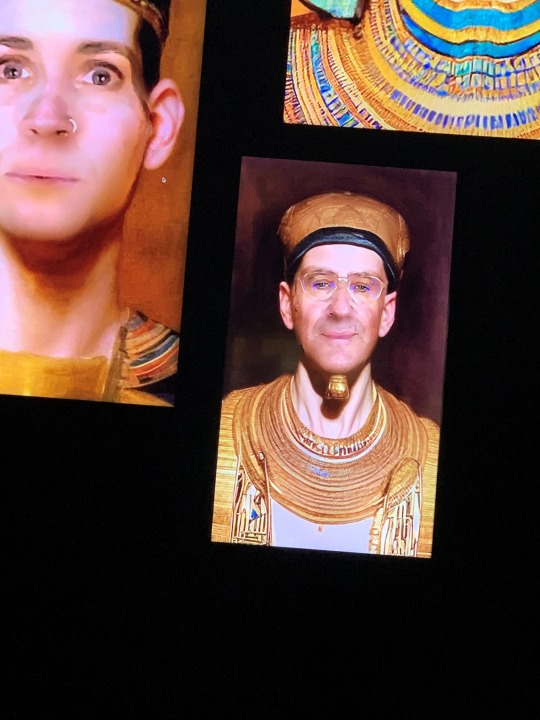
One of the fun activities of this exhibition was to enter a photo booth and choose to have your photo displayed as one of many Egyptian characters. Joan chose this guy and darned if it didn´t actually look quite a bit like him!

After visiting the exhibition we walked on the Poble Nou Rambla and then went to a cafe for an afternoon snack. It was a lovely, cool afternoon and we all enjoyed the exercise and the camaraderie.

Because I´m still fasting with the One Meal a Day fast to support the innocent people who are being starved, some of them to death, in Gaza, the Congo, and Sudan, by the greedy, selfish, brutal governments which are controlled by the multinational weapons industry and other aspects of the Patriarchy controlling our world, I was grateful to eat dinner early tonight. We went with our friends, who are also our neighbors, Antonio and his daughter, Carla, to Seasons Tapas, where the food is delicious and they have quite a few vegan options.
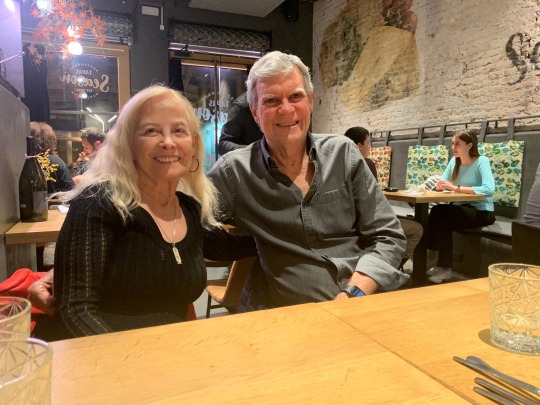

Antonio is a widower and raised his daughter from the age of five by himself, after his wife, Christina, died of cancer. He has done a great job because Carla is intelligent, kind, thoughtful, and obviously adores her dad. Being a teenager she is forging as independent a life for herself as she can, while still spending lots of time with Antonio.
0 notes
Photo

King Tut Wasn’t a Very Important Pharaoh
Tutankhamun is perhaps that most famous ancient Egyptian pharaoh, a household name due to National Geographic, Discover Channel, and History Channel specials. Ask any common person to name off ancient Egyptian kings and most will able to name Cleopatra and King Tut, some might be able to name Ramses. Ask anyone why King Tut is important, 99% of people probably couldn’t give you an answer. The funny thing is Tutankamun wasn’t really an important pharaoh in Egyptian history. Read any biography on him or look at his Wikipedia page and there isn’t much about his life. Most of what is written about him is modern information from well after he was dead.
What did he do during his reign? Not much. He was the son of a pharaoh famous to historians named Akhenaten, but just because his daddy was important doesn’t mean he was important. His reign lasted 9 years and he was only 17 when he died. For most of his reign he probably didn’t actually rule. Most of the governing of Egypt was probably done by regents, ministers, and advisers. He made changes to religious practices, reversing his father’s radical religious policies. He moved the capital. He did a little bit of diplomacy. He won a few battles that most likely he was not actually present for. Blah blah blah he did some stuff nobody cares about or remembers anymore. King Tut was no Caesar, Napoleon, or Alexander the Great. He didn’t do anything that really makes him noteworthy that survives the test of time. So why is it that he isn’t like the scores of Egyptian pharaohs whose wikipedia pages consist of little more than a short paragraph? Why is he a household name today?
The reason for Tutankamun’s modern fame has nothing to do with his life, rather his fame is a result of his afterlife. In 1922 British archaeologist Howard Carter discovered King Tut’s tomb. The rare and amazing thing about his tomb was that for the most part it was left untouched and intact. In fact it’s the best preserved tomb discovered in the Valley of the Kings. Most ancient Egyptian tombs have been raided and ransacked millennia ago. That’s why the ancient Egyptians stopped building pyramids and shifted to well hidden underground tombs. A giant pyramid is just a big advertisement for tomb robbers that screams, “Hey! Over here! This is my tomb and it’s filled with gold and jewels! Come rob it!” The discovery of King Tut’s tomb was a major score for Egyptology, as it was complete with intact carvings, hieroglyphics, wall paintings, and over 5,000 items including precious gold, silver, and bejeweled treasures. From this Egyptologists have been able to disseminate a treasure trove of knowledge about ancient Egyptian culture, religion, and history. Plus, when after thousands of years your tomb is discovered filled to the brim with swag with your corpse covered in bling, people will think you are pretty dope! And that’s why King Tut is famous today.
youtube
300 notes
·
View notes
Text
The Mummy
Tomb robbing has been a tradition in Egypt since time immemorial. Not just the tombs in the Valley of the Kings or the Pyramids, even the tombs of the pre-dynastic rulers fell victim, much to the dismay of archaeologists who found them empty. Only Tutankhamen's contained most of its contents and there was evidence that the tomb had been broken into.
The sentences for robbing the pharaohs' graves were harsh and carried out without mercy. No wonder some resorted to dropping their plundered treasures when they heard the sound of the guards at their heels. Some loot was retrieved by the guards but some enterprising thieves were able to hide their spoils with the intention of returning at a later date to retrieve them. Some did, but archaeologists theorized that hidden in the valley lay caches of precious materials that had lain untouched for centuries. All that remained was finding the way to bring them to light.
Archaeologists occasionally stumbled onto these caches, not realizing what they had found. It wasn't until Carter found five gold rings tied up in a scarf that thieves had dropped that it became evident that some loot was either deliberately or inadvertently left behind.
It was thought that such caches were exclusive to the Valley of the Kings until a stash of jewelry and unguents was found in the lost workers' village of Deir el Medina. The village had been walled and was guarded night and day by the guards of the Valley, the Medjay would search each worker as they entered and exited the village. But the prospect of ill-gotten gold surely had tempted the guards just as easily as it tempted the workers who were responsible for placing the dead pharaohs grave goods into their tombs.
Though the theory was widely dismissed, certain archaeologists gave it credence, it was more than likely than the stolen treasures did not all make it to their destinations. Perhaps of necessity it had been dropped or hidden, but some surely had been deliberately stashed away in the hopes of the thief finding a better price. The most likely recipients of the goods had been the priests or the officials in charge of the valley.
After much research, Professor Thomas Wilkes-Emberly believed that the caches not only existed, but he believed he had stumbled upon one and was convinced there were more to be found if one was only patient enough to take the time to look.
Ostensibly he was an expert on identifying royal mummies, one cache having been found near the village of Qurna and guarded and exploited by the infamous Rassul family, and the other in the tomb of Amenhotep II. Every king of the eighteenth and nineteenth dynasty was accounted for, save one, but there were unknown bodies also laying in the tomb. Wilkes-Emberly was not so sure that all the kings were correctly identified, all he could do was assist the Egyptian authorities in arranging them in a display in the Egyptian Museum.
His daughter, Roma, was his assistant and right-hand man. She had obtained a masters in Egyptology at the Sorbonne in Paris and was hoping to publish the history of her and her father's work over the years and obtain her doctorate. She was fluent in several languages besides her native English and could converse in fluent Arabic and French which helped greatly in her father's dealing with the head of antiquities. She could read heiroglyphics and heiratic, as well as ancient Greek and Latin.
She had grown up in Egypt, along with her father and mother. When her mother died during a cholera epidemic, she had accompanied her body to France and stayed with relatives for a few years, attending a Jesuit school in Paris. At her father's request she had returned to Egypt and worked with him until it was time for her to enter the Sorbonne at the request of her mother's family.
He couldn't have asked for a better partner. She got along well with the diggers, knew their families and the names of their wives and children. It was she who decided that they were badly underpaid and insisted that her father pay them a fair wage, resulting in his having the best diggers in Egypt.
He could not do without her but he had begun to worry for her. Roma was a lovely young woman but she had cut her hair fashionably, though shockingly, short and he did not remember the last time he had seen her in a dress. She had recently turned twenty-five and he was beginning to grow nostalgic over the thought of grandchildren, but she had had only one brief romance with an official at the museum, and he had been Egyptian.
Roma thought there was nothing wrong with her life, she was doing what she loved best. If there were one thorn in her side it was Ardeth-Bey, a member of the Bedoin tribe who often did work for her father. Ardeth was the son of the tribe's sheikh and clearly thought she was above herself. She remembered the day she came to the camp with her newly shorn hair and the look of outrage on his face at what she had done.
It was bad enough, in Ardeth's opinion, that she dressed like a man, supervised the workers as if it were her right, but now when she should be married and having children—the sacred duty of a woman—she showed no inclination. She was a hard worker and of much help to her father, but it was time she outgrew her hoydenish ways.
"He fancies you, you know," her father had told her, "But he knows of no other way to show it."
"Ha!" she replied, "He fancies only himself. Just wait, in a few years he'll have his four wives allowed by the Quran and lord it over them which he could never do to me. He resents the fact that I am a liberated woman and I do exactly as I like. That does not suit Ardeth-Bey at all, and he'll become even more unbearable when he succeeds his father as sheikh."
She had taken the boat to Cairo to obtain the concession for her father to continue digging in Deir El Medina. They had wanted to obtain permission to dig in the Valley of the Kings but Howard Carter had somehow managed to tie it up yet again. She had heard strange rumors about Carter and his patron Lord Carnarvon. They had been digging in the valley for six years with no results, and it was rumored that Carnarvon had wanted to quit. Carter had offered to fund the excavation himself but out of friendship Carnarvon had insisted on paying for this one last season.
Rumors had drifted up to the worker's village. The diggers were expected to be tight lipped about their employers but she had heard that Carter had indeed found something. Some steps had been discovered and now gossip was spreading about how they had found a sealed door and were in the process of clearing a corridor.
She didn't like Carter; he was a cold unfriendly man but under the tutelage of Flinders Petrie had become a more than competent archaeologist. It was highly likely that he had found a tomb, and if he had she wished him well. He had worked seven years for this, and if he had found the long-lost tomb of Tutankhamen that he sought, more power to him.
After obtaining her father's concession she spent the day wandering around Cairo. The lines to the museum were long but whenever she visited Cairo she always went to the museum, the market, and the Coptic church. After that she would go to their Cairo residence to determine that the servants were keeping it cleaned and aired out for when she and her father returned after digging season. She would spend the night in her room then catch the boat back to Luxor.
She never tired of taking the boat up and down the Nile. She loved to watch the feluccas skimming their way across the Nile. There were birds and the occasional crocodile or even hippo if she was lucky. Fishermen would toss their nets, an enterprising boatman or two would ferry tourists. The Nile was a thing alive and full of wonder.
She was tired when she reached their house in Luxor. "Father, I have it, we're cleared to dig for next year," she called but he did not answer. "Father?" she asked, then heard voices outside on the patio.
#the mummy#Egypt#Rick O'Connell#Evelyn Carnahan#Valley of the Kings#Cairo#Luxor#Ardeth-bey#Nile#Villa#mummy#curse
2 notes
·
View notes
Text
Ten Spring Reads To Watch For
Yeah, the shift toward warmer weather and cool evenings sipping beer after some grueling lawncare is great and all, but for me the best part of spring is the blossoming of new books. From the looks of things, there's a boatload of promising intrigue, blood-curdling chills, and action-packed adventures ahead. While it's a sure bet I have plenty of other books in my TBR and review pile, here's the Top 10 spring reads I am most looking forward to.
One Way by S.J. Morden
April 10, 2018 | Orbit
When the small crew of ex cons working on Mars start getting murdered, everyone is a suspect in this terrifying science fiction thriller from bona fide rocket scientist and award winning-author S. J. Morden.
It's the dawn of a new era - and we're ready to colonize Mars. But the company that's been contracted to construct a new Mars base, has made promises they can't fulfill and is desperate enough to cut corners. The first thing to go is the automation . . . the next thing they'll have to deal with is the eight astronauts they'll send to Mars, when there aren't supposed to be any at all.
Frank - father, architect, murderer - is recruited for the mission to Mars with the promise of a better life, along with seven of his most notorious fellow inmates. But as his crew sets to work on the red wasteland of Mars, the accidents mount up, and Frank begins to suspect they might not be accidents at all. As the list of suspect grows shorter, it's up to Frank to uncover the terrible truth before it's too late.
Dr. S. J. Morden trained as a rocket scientist before becoming the author of razor-sharp, award-winning science fiction. Perfect for fans of Andy Weir's The Martian and Richard Morgan, One Way takes off like a rocket, pulling us along on a terrifying, epic ride with only one way out.
They Feed by Jason Parent
April 15, 2018 | Sinister Grin Press
The night uncovers all we wish not to see. A troubled man enters a dusky park before sunset. A young woman follows, hidden in shadow. Both have returned to the park to take back something the past has stolen from them, to make right six long years of suffering, and to find justice or perhaps redemption—or maybe they'll settle for some old-fashioned revenge. But something evil is alive and awake in those woods, creatures that care nothing for human motivations. They’re driven by their own insatiable need: a ravenous, bottomless hunger. The campgrounds are full tonight, and the creatures are starving. Before the night is over, they will feed. An unrelenting tale of terror from Jason Parent, acclaimed author of People of the Sun and What Hides Within.
Breaking the World by Jerry Gordon
April 17, 2018 | Apex Books
Cyrus doesn't believe in David's predictions, and he's not interested in being part of a cult. But after the sudden death of his brother, his parents split up and his mom drags him to Waco, Texas against his will. At least he's not alone. His friends, Marshal and Rachel, have equally sad stories that end with them being dumped at the Branch Davidian Church. Together, they're the trinity of nonbelievers, atheist teens caught between a soon to be infamous cult leader, an erratic FBI, and an epidemic that may confirm the worst of the church's apocalyptic prophecies. With tanks surrounding the Branch Davidians and tear gas in the air, Cyrus and his friends know one thing for certain: They can't count on the adults to save them. In his debut novel, Jerry Gordon takes readers deep inside the longest standoff in law enforcement history for an apocalyptic thriller that challenges the news media's reporting of the event, the wisdom of militarizing domestic law enforcement, and the blurry line between religion and cult.
The Atrocities by Jeremy C. Shipp
April 17, 2018 | Tor.com
Jeremy Shipp brings you THE ATROCITIES, a haunting gothic fantasy of a young ghost's education
When Isabella died, her parents were determined to ensure her education wouldn't suffer.
But Isabella's parents had not informed her new governess of Isabella's... condition, and when Ms Valdez arrives at the estate, having forced herself through a surreal nightmare maze of twisted human-like statues, she discovers that there is no girl to tutor.
Or is there...?
Forsaken (A Unit 51 Novel) by Michael McBride
April 24, 2018 | Pinnacle
IT HAS SURVIVED At a research station in Antarctica, scientists discovered a strange and ancient organism. They thought they could study it, classify it, control it. They couldn’t. IT HAS THRIVED Six months ago, a secret paramilitary team called Unit 51 was sent to the station. They thought the creature was dead, the nightmare was over. It wasn’t. IT HAS EVOLVED In a Mexican temple, archeologists uncover the remains of a half-human hybrid. They believe it is related to the creature in Antarctica, a dark thing of legend that is still alive—and still evolving. They believe it needs a new host to feed, to mutate, to multiply. They’re right. And they’re next. And the human race might just be headed for extinction . . .
Fury From the Tomb: The Institute for Singular Antiquities Book 1 by S.J. Morden
May 1, 2018 | Angry Robot Books
Mummies, grave-robbing ghouls, hopping vampires, and evil monks beset a young archaeologist, in this fast-paced Indiana Jones-style adventure Saqqara, Egypt, 1888, and in the booby-trapped tomb of an ancient sorcerer, Rom, a young Egyptologist, makes the discovery of a lifetime: five coffins and an eerie, oversized sarcophagus. But the expedition seems cursed, for after unearthing the mummies, all but Rom die horribly. He faithfully returns to America with his disturbing cargo, continuing by train to Los Angeles, home of his reclusive sponsor. When the train is hijacked by murderous banditos in the Arizona desert, who steal the mummies and flee over the border, Rom – with his benefactor’s rebellious daughter, an orphaned Chinese busboy, and a cold-blooded gunslinger – must ride into Mexico to bring the malevolent mummies back. If only mummies were their biggest problem…
Obscura by Joe Hart
May 8, 2018 | Thomas & Mercer
She’s felt it before... the fear of losing control. And it’s happening again.
In the near future, an aggressive and terrifying new form of dementia is affecting victims of all ages. The cause is unknown, and the symptoms are disturbing. Dr. Gillian Ryan is on the cutting edge of research and desperately determined to find a cure. She’s already lost her husband to the disease, and now her young daughter is slowly succumbing as well. After losing her funding, she is given the unique opportunity to expand her research. She will travel with a NASA team to a space station where the crew has been stricken with symptoms of a similar inexplicable psychosis—memory loss, trances, and violent, uncontrollable impulses.
Crippled by a secret addiction and suffering from creeping paranoia, Gillian finds her journey becoming a nightmare as unexplainable and violent events plague the mission. With her grip weakening on reality, she starts to doubt her own innocence. And she’s beginning to question so much more—like the true nature of the mission, the motivations of the crew, and every deadly new secret space has to offer.
Merging thrilling science-fiction adventure with mind-bending psychological suspense, Wall Street Journal bestselling author Joe Hart explores both the vast mysteries of outer space and the even darker unknown that lies within ourselves.
Hell Divers III: Deliverance by Nicholas Sansbury-Smith
May 15, 2018 | Blackstone Publishing
Left for dead on the nightmarish surface of the planet, Commander Michael Everhart and his team of Hell Divers barely escape with their lives aboard a new airship called Deliverance. After learning that Xavier ��X” Rodriguez may still be alive, they mount a rescue mission for the long-lost hero.
In the skies, the Hive is falling apart, but Captain Jordan is more determined than ever to keep humanity in their outdated lifeboat. He will do whatever it takes to keep the ship in the air—even murder. But when he learns the Hell Divers he exiled have found Deliverance, he changes course for a new mission—find the divers, kill them, and make their new ship his own.
In the third installment of the USA Today bestselling Hell Divers series, Michael and his fellow divers fight across the mutated landscape in search of X. But what they find will change everything.
Blood Standard by Laird Barron
May 29, 2018 | G.P. Putnman's Sons
Award-winning author Laird Barron makes his crime fiction debut with a novel set in the underbelly of upstate New York that's as hardboiled and punchy as a swift right hook to the jaw--a classic noir for fans of James Ellroy and John D. Macdonald. Isaiah Coleridge is a mob enforcer in Alaska--he's tough, seen a lot, and dished out more. But when he forcibly ends the moneymaking scheme of a made man, he gets in the kind of trouble that can lead to a bullet behind the ear. Saved by the grace of his boss and exiled to upstate New York, Isaiah begins a new life, a quiet life without gunshots or explosions. Except a teenage girl disappears, and Isaiah isn't one to let that slip by. And delving into the underworld to track this missing girl will get him exactly the kind of notice he was warned to avoid.
The Woman in the Woods by John Connolly
June 12, 2018 | Atria/Emily Bestler Boks
From internationally bestselling author and “creative genius who has few equals in either horror fiction or the mystery genre” (New York Journal of Books) comes a gripping thriller starring Private Investigator Charlie Parker. When the body of a woman—who apparently died in childbirth—is discovered, Parker is hired to track down both her identity and her missing child. In the beautiful Maine woods, a partly preserved body is discovered. Investigators realize that the dead young woman gave birth shortly before her death. But there is no sign of a baby. Private detective Charlie Parker is hired by a lawyer to shadow the police investigation and find the infant but Parker is not the only searcher. Someone else is following the trail left by the woman, someone with an interest in much more than a missing child…someone prepared to leave bodies in his wake. And in a house by the woods, a toy telephone begins to ring and a young boy is about to receive a call from a dead woman.
I'm also planning on digging into several titles that have been lingering in my review pile for quite a while, including the Bram Stoker Award-nominated Kill Creek by Scott Thomas. What's on your reading list for the next couple months ahead?
0 notes
Photo
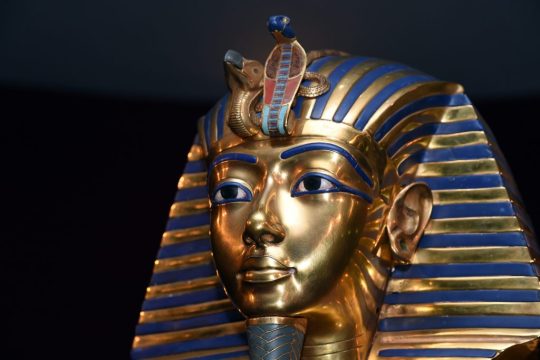
The 5 Most Opulent Artifacts Found in King Tut’s Inner Tomb
All that glitters is sometimes gold—particularly when it comes to the tomb of King Tutankhamun.
There is perhaps no other period in human history that has captured minds and imaginations quite like ancient Egypt. “Egyptomania,” or the intense interest in all thing Egypt, was first sparked by Napoleon’s Egyptian Campaign at the turn of the 19th century. Throughout the 1800s, people across the world emulated the architecture and design of Egyptian culture—for example, Victorian-era jewelry frequently incorporated scarabs, and cartouches and monuments across Europe took the form of obelisks.
The pervasive obsession with Egypt reached an apogee when on November 26, 1922, archaeologist Howard Carter and his team discovered the doorway to the tomb of Pharaoh Tutankhamun (commonly referred to as King Tut) in the Valley of the Kings on the west bank of the Nile. Though archaeological digs had been undertaken throughout the area, most tombs had succumbed to looting and grave robbing, leaving them stripped bare of their original contents. Tut’s tomb, however, had been hidden by debris and rubble, preserving it to near perfect condition.
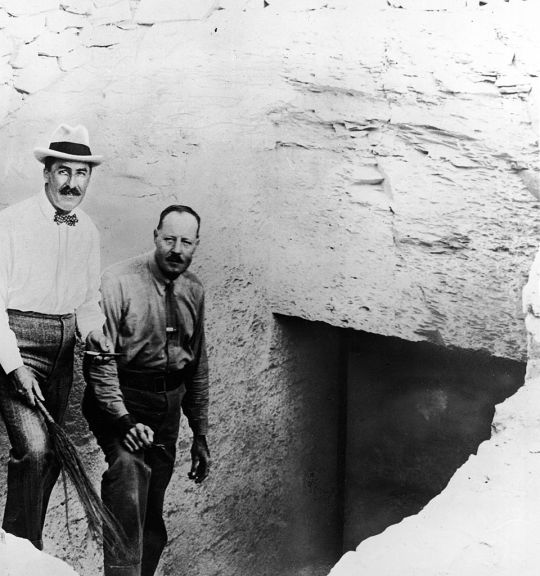
Despite discovering King Tutankhamun’s tomb in late 1922, it took several months for archaeologists to work their way through and catalogue the contents within the outer chambers. On February 16, 1923, Carter finally came face-to-face with the doorway leading to the tomb’s inner burial chamber and unsealed it. What he and his team were met with was the most well-preserved and intact pharaonic tombs ever found. Over the following eight years, the items and goods contained therein were carefully catalogued and removed, and today are held in the collection of the Egyptian Museum in Cairo.
To mark the centennial of the unsealing of the burial chamber, we’ve gathered five of the most opulent and intriguing artifacts that were found in King Tutankhamun’s tomb.
Tutankhamun’s Sarcophagus and Three Coffins:

Seeing the sarcophagus was perhaps one of the most exciting moments for the archaeologists at the time, as it indicated early on that the contents were preserved and intact. Crafted of quartzite and red granite, and displaying the images of Isis, Nephthys, Neith, and Serqet, the sarcophagus housed three nesting coffins which held Tutankhamun’s mummified body. The outer two coffins are made of fully gilded wood and inlaid with glass and semiprecious stones, such as turquoise and lapis lazuli. The innermost coffin, however, is made almost entirely out of 110.4 kilos of solid gold, similarly adorned with inlaid stones, and incised with inscriptions and in the shape of Osiris holding scepter and flail.
The Death Mask of Tutankhamun

Found within the innermost coffin upon the mummified body, King Tut’s death mask has become a world-recognized icon of ancient Egypt and the pharaonic era. Composed of 10.23 kilos of solid gold, it depicts Tutankhamun wearing the traditional stripped pharaonic headdress replete with representations of the goddesses Nekhbet and Wadjet above his brow. The mask’s back and shoulders are inscribed in Egyptian hieroglyphs with a protective spell copied from the Book of the Dead, offering protection as the pharaoh moved through the underworld.
Canopic Shrine

In the process of mummification, many of the person’s organs are removed and placed in what are called canopic jars. These containers frequently included lids shaped after the heads of the Sons of Horus, protective deities. Like many other ancient Egyptian tombs, King Tut’s included an alabaster canopic chest containing the four separate jars. However, in the pharaoh’s tomb, these were housed in a canopic shrine. Standing at six-and-a-half feet tall and enrobed in gold, the shrine includes the figure of the goddess Nepthys who stands guard over the royal contents.
Golden Sandals
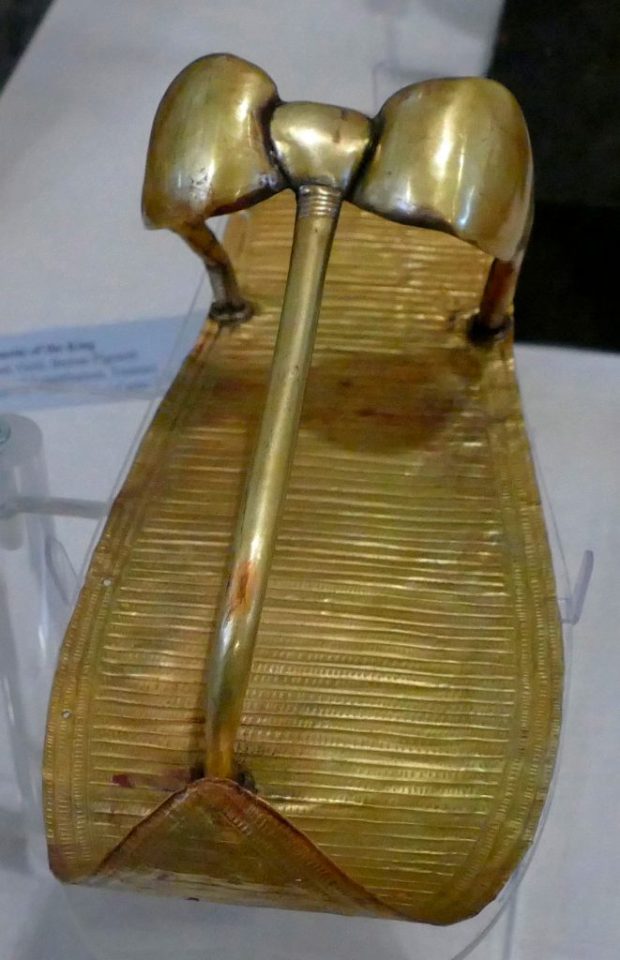
A large swathe of the items found in King Tutankhamun’s tomb represented personal necessities, such as clothing, toiletries like perfume, and food stuffs. Included among these items were a pair of gold sandals. These golden shoes have been found in numerous other ancient tombs, and it is believed that they were made specifically for funerary and burial practices. The soles of the shoes depict the nine traditional enemies of Egypt, including the Nubians and Libyans, symbolizing that as god-king they were literally beneath his feet.
Golden Chariot
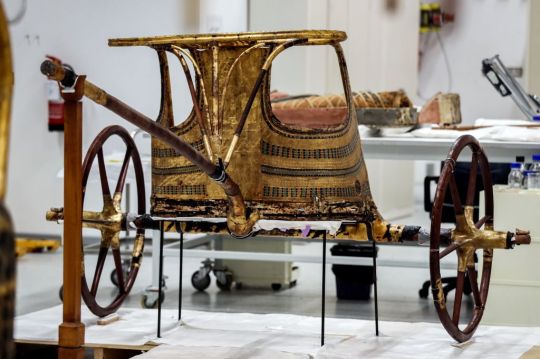
King Tutankhamun’s tomb contained a total of six golden chariots—though, unfortunately, all were in various states of disrepair as they were either mishandled or damaged by looters. After restoration, they were identified as typical D-cab chariots that were meant to be drawn by two horses. The image of a pharaoh driving a chariot was a common symbol of royal power and wealth, and in ancient times, pharaohs were often presented at public events in opulent chariots to highlight their status.
By Annikka Olsen.
#The 5 Most Opulent Artifacts Found in King Tut’s Inner Tomb#King Tutankhamun#Howard Carter#ancient tombs#ancient graves#ancient artifacts#archeology#archeolgst#valley of the kings#gold#treasure#history#history news#ancient history#ancient culture#ancient civilizations#ancient egypt#egyptian history#egyptian pharaoh#egyptian art
54 notes
·
View notes